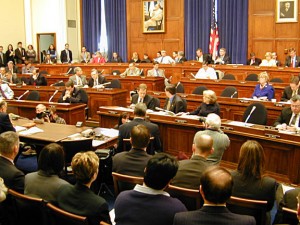A Broken System
 A recent article in Esquire magazine outlined how badly Congress is broken (November 2014 issue). It quoted current Congressmen from both parties who went to Washington to make a difference and find themselves deeply frustrated with what they can only describe as a broken system.
A recent article in Esquire magazine outlined how badly Congress is broken (November 2014 issue). It quoted current Congressmen from both parties who went to Washington to make a difference and find themselves deeply frustrated with what they can only describe as a broken system.
Anyone who watches or reads the news on a regular basis is aware just how dysfunctional Congress has become.
The very next article in the same magazine is dedicated to fixing Congress. It reports on a bipartisan meeting of Congressional icons who met and hammered out just what it would take to end the dysfunction.
The group sat around a long conference table, brainstormed, discussed, analyzed, and came up with twenty-two changes that might get Congress back on track.
With this kind of build up, I read their conclusions closely. Frankly, I was excited to see a group genuinely trying to come up with solutions.
It sounded like the group Orrin Woodward and I outlined in our book LeaderShift—with almost the same purpose. Of course, our group met to fix America, not just Congress, but I was still very intrigued.
The more I read, however, the more disappointment I felt.
To Laugh or To Cry
The panel’s recommended changes included things like limiting members of Congress to two committees, not allowing floor votes in the mornings so that committees can meet uninterrupted, and encouraging more joint-house meetings and discussions.
By the time I finished the article, I wasn’t sure whether to cry or laugh. I found myself shaking my head slowly, wondering why we’re so far from our founding.
I got out my pen and a blank piece of paper and decided to see if I could up with something better than three pages of mostly cosmetic proposals. Here’s what I wrote first:
“Repeal the 17th Amendment”
Then I sat and tried to come up with something else. I pondered. I wracked my brain. “There’s got to be more,” I told myself. I thought of the great resolutions we outlined in LeaderShift, but in this case I was focused only on Congress. After a while I looked again at what I just had written.
“Repeal the 17th Amendment”
Finally I wrote:
“Or make the same change in some other way.”
I sat back and smiled. Every time I try to find ways to improve the Constitutional structure, or read about someone else who tries the same thing, I am amazed at how wise the American framers were. With the exception of slavery, they wrote an amazingly effective document. Of course, slavery was a huge evil, enough that the Civil War and over a hundred years of Civil Rights conflicts were necessary.
A Great Document
Take slavery out, and the framers wrote a truly excellent document. So much so that if we repealed the 17th Amendment right now, it would accomplish everything the Congressional experts try to do with their 22 changes and pages of explanations. This is a big deal. The Constitutional system wasn’t perfect, but it was amazingly good.
If we would apply it today, we’d be shocked as a nation at how many problems it would solve. Before the 17th Amendment, Congress was designed in a specific, very wise way.
The House was elected by the popular vote in each state, and thus naturally represented the people in that state. The Senate was appointed by the state legislature of each state, and as a result represented the state itself.
With the passage of the 17th Amendment in 1913, nobody any longer represented the states—at least not in the federal government. This unbalanced the system of checks and balances that had been carefully framed by the founding fathers.
Specifically, the founders knew that any branch of government naturally seeks to increase its power, so it set up the top power centers to face off against and check each other.
Federal and National
The framers structured our system so that the Executive would represent the nation in dealings with foreign powers, the Court would represent the Constitution and work to keep it from being ignored or improperly altered, the House would represent the people of the nation, and the Senate would represent the States in the union.
This is basic, but it gets deeper: The framers also designed the system so that when the president wanted to appoint ambassadors, secretaries of departments like State or Defense, and Supreme Court and other federal judges, he would need the approval of the Senate to do so.
The reason for this is that the Senate represented the States, and the framers knew that if the judges were chosen by the president and the House (who represent the people), the consequence would be a Court that consistently gave more and more power to the federal government—by taking less and less from the States and Locales.
When the 17th Amendment changed the Senate from a representative of the States to just another representative of the people, the natural result was the end of federal government and the beginning of national government. The difference is significant.
In a federal system, the federal government oversees national security and diplomacy and leaves the rest to the States and the People. In a national model, the national government rules the states as inferior subunits.
Which brings us up to today.
An Actual Solution
Everything dysfunctional about Congress (and a large portion of the problems in the Executive and Judicial branches) would be quickly resolved if we repealed the 17th Amendment and brought back the balance in our government.
We don’t need 22 shallow new proposals for how to make Congress less dysfunctional. We just need to actually understand and follow the Constitutional principles of freedom.
Congress—and Washington—will remain dysfunctional and broken until the balance is restored. As long as the States are frequently treated as mere extensions of the national government, the problems will continue to grow.
The Court will continue to represent popular trends rather than the Constitution, and it will keep funneling more power to Washington and away from the people.
At the same time, national spending, taxes, debt, deficits, economy-hurting regulations, and bad policies will multiply. We have an unbalanced system, but it is easily changed with four words:
“Repeal the 17th Amendment”
Congress and Washington won’t be fixed until this—or something that accomplishes the same return to balance—happens. Period.
(For more suggestions on specific changes that would bring real solutions to Congress and America in these times of political dysfunction, see the 9 Resolutions in the book LeaderShift by Orrin Woodward and Oliver DeMille.)
 Oliver DeMille is the New York Times, Wall Street Journal and USA Today bestselling co-author of LeaderShift: A Call for Americans to Finally Stand Up and Lead, the co-founder of the Center for Social Leadership, and a co-creator of TJEd.
Oliver DeMille is the New York Times, Wall Street Journal and USA Today bestselling co-author of LeaderShift: A Call for Americans to Finally Stand Up and Lead, the co-founder of the Center for Social Leadership, and a co-creator of TJEd.
Among many other works, he is the author of A Thomas Jefferson Education: Teaching a Generation of Leaders for the 21st Century, The Coming Aristocracy, and FreedomShift: 3 Choices to Reclaim America’s Destiny.
Oliver is dedicated to promoting freedom through leadership education. He and his wife Rachel are raising their eight children in Cedar City, Utah.






Speak Your Mind
You must be logged in to post a comment.